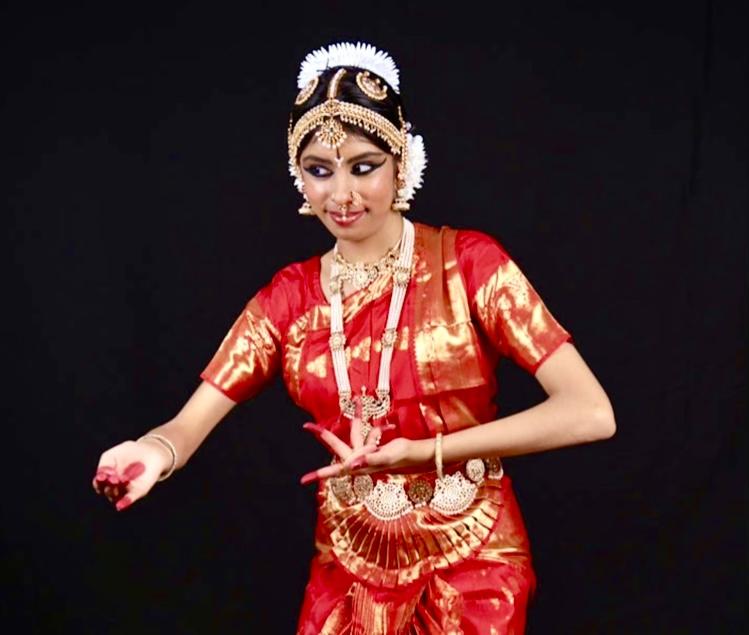Dressed in a resplendent red and gold pleated pant costume, senior Ameya Saund watches herself dance in the mirror at home as she practices crisp arm and leg movements known as adavus — which are basic foundational movements in the style of Bharatanatyam, one of the nine forms of classical Indian dance. She spends at least three hours daily running through her Bharatanatyam dances and fine-tuning her movements.
Saund is preparing for her arangetram — directly translating to “ascending the stage,” an arangetram is the on-stage debut performance of a former Indian classical dance student. Her 2-hour solo, scheduled to take place in early March in a location that is still being determined, will showcase the skills she has learned over the course of her nine years of dancing.
“My arangetram is the culmination of everything I’ve learned,” she said. “It’s a really important dance graduation performance, and it takes a lot of time and effort to actually pull it off.”
Arangetrams are usually colorful, energetic celebrations, with expenses for live musicians, food, custom-made costumes and jewelry often adding up to thousands of dollars. Saund thinks at least 200 people, including family, friends and relatives from both the U.S. and India, will attend.
“I’m a bit stressed, but it’s normal,” she said. “I know that all I need to do is practice and I’ll be ready.”
Arangetrams demand nearly a decade of instruction before a teacher decides a student is ready for a public debut. Saund has been training since third grade under the tutelage of Mythili Kumar, an award-winning dancer and the founder of Abhinaya Dance Company in San Jose.
In her preparation so far, one of Saund’s greatest challenges is to build the stamina required to dance continuously for long periods of time.
“I have seen many arangetrams where girls mess up their steps at the end because they’re out of energy,” she said. “So my goal is just to keep up my stamina throughout my performance.”
Saund’s arangetram will feature seven dances — each from a different stage of her Bharatnatyam education — spliced together roughly in the order that she learned them. Simpler dances will be generally featured at the beginning while more complex ones will be at the end. There will also be an intermission for Saund to change her costume.
She will begin her arangetram with a pushpanjali, which translates to “floral salutation,” during which she will offer flowers to Lord Nataraja, the Hindu god of dance.
Next, she will showcase pashunam patim, a 6-minute dance describing the characteristics of Lord Nataraja. This is followed by an alarippu — a compilation of basic steps which demonstrates her control over different body parts such as the eyes, neck, hands and legs. Her performance will also include a jathiswaram, a set of steps executed to repeated musical notes set against a nine beat rhythm.
The longest and most intricate dance in Saund’s repertoire is her varnam: a 38-minute piece called Simhavahini, which translates to “the goddess who rides a lion.” This dance depicts many stories from Hindu folklore, one of which is the tale of how a poor woman offers her last gooseberry to a brahmin. To reward the woman’s generosity, Lakshmi, the Hindu goddess of good fortune, showers the woman with golden gooseberries.
From her training, Saund has learned how to express cultural stories like these through abhinaya, the technique of using facial expressions and hand gestures to convey emotion.
“When I dance, I have to portray the meanings of the songs that I’m dancing to, and it’s really cool that I get to learn about stories from Hindu mythology,” she said. “Bharatanatyam has definitely connected me to my culture.”
Saund has also discovered a sense of community with other Bharatanatyam dancers while taking group lessons together at Abhinaya Dance Company. She recalls watching other students’ arangetrams from backstage — and on one occasion, assisting another dancer during their performance by waving at them to prevent them from bumping into a speaker onstage.
“A lot of my friends did their arangetrams this year, and if we were doing a similar dance, I would go watch them,” Saund said. “I feel really proud of them. Seeing someone do a good arangetram inspires me to want to dance more — it’s a really interesting and fun art form to watch.”
Although Saund’s arangetram will mark her “graduation” from classical Indian dance, she intends to continue staying involved with the community by teaching younger dancers. In addition, she plans to participate in other dance shows such as Bombay in the Bay in February.
Though she has experience with many different genres of dance, Saund ultimately credits Bharatanatyam and Abhinaya Dance Company for providing her with the foundational skills to become a good dancer.
“I want to give back to the community that’s given me so much,” she said. “So I want to teach a lot of other kids and anybody who’s interested in dancing, because I really love to dance and I just want to spread that.”
























